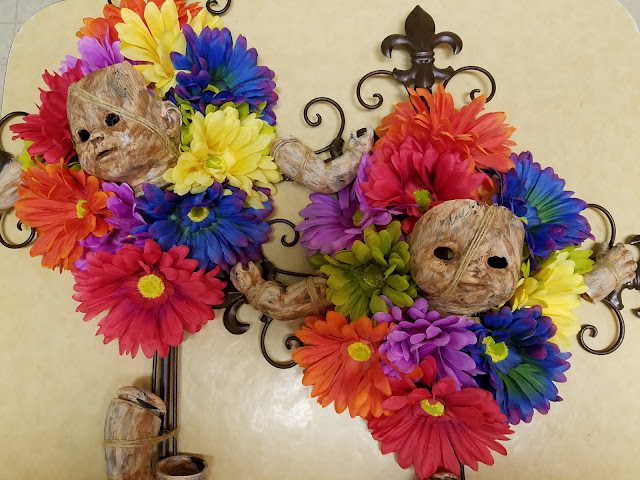$25 - $30 (based on 2017 prices)
Makes two crosses
2017’s haunt explored the legend of La Llorona. To expand on the element of prolicide prevalent in the folklore, I drew inspiration from La Isla de las Muñecas and filled the haunt with dolls to represent the specter’s drowned children. Likewise, many of the builds incorporated touches of Catholicism and Mexican culture, namely attributes surrounding Día de los Muertos. For this prop, I incorporated multiple elements from both – crosses, dismembered dolls, and multicolored flowers – to help unify the themes.
- Two twelve-inch vinyl dolls
- Two twenty-four-inch metal crosses
- One 2 oz. bottle of acrylic paint in flat black*
- One 2 oz. bottle of acrylic paint in flat brown*
- One 2 oz. bottle of acrylic paint in flesh tone*
- One 8 oz. bottle of wood glue*
- Two to three yards of light brown twine
- Forty-four artificial gerbera daisies in various colors
1. Remove the dolls’ clothing and dismember them. I wanted these props to act as sconces in the haunt, so I hollowed out their eyes and removed the backs of their heads to allow for LED lights. This step, of course, is entirely optional.
2. On a newspaper-lined surface in a well-ventilated area, paint their limbs and heads black. Although I only used one coat, you may want more depending on your desired coverage. Keep in mind, though, that this is the base coat for the crackle paint and much of it will be covered up by the second layer. While I chose black, you can use a different color to tailor the props for your specific needs.
3. Once the paint has dried, use a thick brush to apply a smattering of wood glue to the props. Try not to over think your application (a random pattern produces the best results). Also, it may be easier to work with one limb at a time rather than attempting to glue and paint the entire lot at once. Let the glue sit for a minute to become tacky and then cover the limbs with the flesh-tone paint. Here, too, I only used one coat; however, you may want more. As the glue and paint dry, they will form cracks, making the base coat visible.
4. Once the glue and paint have fully dried, brush a light coat of brown paint onto the props to simulate dirt. During this process, try to focus on areas where dust and grime would normally accumulate: in the lines between fingers and toes, along the creases of elbows and knees, and inside the ears and mouths.
5. Arrange the limbs onto the crosses and glue them in place. You will use the shape of the cross to form the main structure of the body, adding the heads and limbs as accentuations. To give the props further detail, mix and match the pieces, taking parts from each doll and using them to assemble a whole figure.
6. Wrap twine around the limbs and crosses to make it appear as though the dolls have been lashed to them (the glue will hold them in place). Trim the excess and glue the knots to reinforce them.
7. Glue the flowers to the crosses. Their placement and color all depend on your desired appearance for the prop. You can cluster them together to form a body for the dolls or scatter them along the edges of the crosses for a haphazard placement. Likewise, you can select a polychromatic mixture or stick with a single color to emphasize a particular theme. For added bulk, utilize multiple layers.
8. If the crosses did not come with hanging loops, you can create your own with the extra twine, knotting the ends and gluing them for reinforcement.
*You will not use the entire bottle’s content for this project.
















